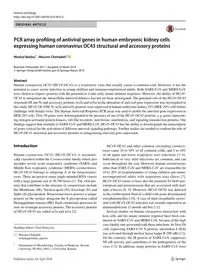
2018 PCR array profiling of antiviral genes in human embryonic kidney cells expressing human coronavirus OC43 structural PDF
Preview 2018 PCR array profiling of antiviral genes in human embryonic kidney cells expressing human coronavirus OC43 structural
Vol.:(0123456789) 1 3 Archives of Virology https://doi.org/10.1007/s00705-018-3832-8 ORIGINAL ARTICLE PCR array profiling of antiviral genes in human embryonic kidney cells expressing human coronavirus OC43 structural and accessory proteins Meshal Beidas1 · Wassim Chehadeh1 Received: 9 November 2017 / Accepted: 22 March 2018 © Springer-Verlag GmbH Austria, part of Springer Nature 2018 Abstract Human coronavirus OC43 (HCoV-OC43) is a respiratory virus that usually causes a common cold. However, it has the potential to cause severe infection in young children and immunocompromised adults. Both SARS-CoV and MERS-CoV were shown to express proteins with the potential to evade early innate immune responses. However, the ability of HCoV- OC43 to antagonise the intracellular antiviral defences has not yet been investigated. The potential role of the HCoV-OC43 structural (M and N) and accessory proteins (ns2a and ns5a) in the alteration of antiviral gene expression was investigated in this study. HCoV-OC43M, N, ns2a and ns5a proteins were expressed in human embryonic kidney 293 (HEK-293) cells before challenge with Sendai virus. The Human Antiviral Response PCR array was used to profile the antiviral gene expression in HEK-293 cells. Over 30 genes were downregulated in the presence of one of the HCoV-OC43 proteins, e.g. genes represent- ing mitogen-activated protein kinases, toll-like receptors, interferons, interleukins, and signaling transduction proteins. Our findings suggest that similarly to SARS-CoV and MERS-CoV, HCoV-OC43 has the ability to downregulate the transcription of genes critical for the activation of different antiviral signaling pathways. Further studies are needed to confirm the role of HCoV-OC43 structural and accessory proteins in antagonising antiviral gene expression. Introduction Human coronavirus OC43 (HCoV-OC43) is taxonomi- cally classified within the Coronaviridae family which also includes severe acute respiratory syndrome (SARS) and Middle East respiratory syndrome (MERS) coronaviruses. HCoV-OC43 belongs to subgroup A of the betacoronavi- ruses. These are positive-sense single-stranded RNA viruses with a large genome size at 30,780 bases [1]. The viral pro- teins that contribute to the structure of coronaviruses include the Membrane (M), Nucleocapsid (N), Envelope (E) and Spike (S) glycoprotein. Betacoronaviruses possess a unique protein on the surface alongside the S glycoprotein called Hemagglutinin esterase (HE). Each coronavirus possesses its own set of unique accessory proteins. The accessory proteins of HCoV-OC43 are called ns2a and ns5a [2]. HCoV-OC43 and other common circulating coronavi- ruses cause 10 to 30% of all common colds, and 5 to 10% of all upper and lower respiratory tract infections [3–6]. Subclinical or very mild infections are common, and can occur throughout the year. However, human coronaviruses other than SARS-CoV and MERS-CoV are responsible for 10 to 20% of hospitalisations of young children and immu- nocompromised adults with respiratory tract illness [7]. HCoV-OC43 seems to have also the potential for both neu- rotropism and neuroinvasion that are associated with mul- tiple sclerosis [8, 9]. Moreover, HCoV-OC43 was detected in the cerebrospinal fluid of a child with acute disseminated encephalomyelitis [10]. A case of fatal encephalitis associ- ated with HCoV-OC43 infection was recently reported in an immunodeficient 11-month-old boy [11]. Several studies on human coronavirus interaction with host cells and the innate immune response have been con- ducted on SARS-CoV and MERS-CoV, because of the high case-fatality rate associated with these infections. In Vero E6 cells expressing SARS-CoV N protein, interleukin 6 (IL6) was activated through nuclear factor kappa B (NF-κB) [12]. On the contrary, the M protein of SARS-CoV suppresses NF-κB activity and contributes to the pathogenesis of the virus [13]. In addition, many proteins in SARS-CoV were Handling Editor: Chan-Shing Lin. * Wassim Chehadeh
